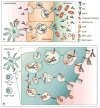FcRn: The Architect Behind the Immune and Nonimmune Functions of IgG and Albumin
- PMID: 25934922
- PMCID: PMC4451002
- DOI: 10.4049/jimmunol.1403014
FcRn: The Architect Behind the Immune and Nonimmune Functions of IgG and Albumin
Abstract
The neonatal FcR (FcRn) belongs to the extensive and functionally divergent family of MHC molecules. Contrary to classical MHC family members, FcRn possesses little diversity and is unable to present Ags. Instead, through its capacity to bind IgG and albumin with high affinity at low pH, it regulates the serum half-lives of both of these proteins. In addition, FcRn plays an important role in immunity at mucosal and systemic sites through its ability to affect the lifespan of IgG, as well as its participation in innate and adaptive immune responses. Although the details of its biology are still emerging, the ability of FcRn to rescue albumin and IgG from early degradation represents an attractive approach to alter the plasma half-life of pharmaceuticals. We review some of the most novel aspects of FcRn biology, immune as well as nonimmune, and provide some examples of FcRn-based therapies.
Copyright © 2015 by The American Association of Immunologists, Inc.
Figures


References
-
- Ehrlich P. Ueber Immunität durch Vererbung und Säugung. Zeitschrift fuer Hygiene und Infektionskrankheiten, medizinische Mikrobiologie, Immunologie und Virologie. 1892;12:183–203.
-
- Brambell FWR. THE PASSIVE IMMUNITY OF THE YOUNG MAMMAL. Biological Reviews. 1958;33:488–531.
-
- Brambell FW, Hemmings WA, Henderson M, Kekwick RA. Electrophoretic studies of serum proteins of foetal rabbits. Proceedings of the Royal Society of London. Series B, Containing papers of a Biological character. Royal Society. 1953;141:300–314. - PubMed
-
- Brambell FW, Hemmings WA, Oakley CL, Porter RR. The relative transmission of the fractions of papain hydrolyzed homologous gamma-globulin from the uterine cavity to the foetal circulation in the rabbit. Proceedings of the Royal Society of London. Series B, Containing papers of a Biological character. Royal Society. 1960;151:478–482. - PubMed
-
- Brambell FW, Hemmings WA, Morris IG. A Theoretical Model of Gamma-Globulin Catabolism. Nature. 1964;203:1352–1354. - PubMed
Publication types
MeSH terms
Substances
Grants and funding
- R37 DK044319/DK/NIDDK NIH HHS/United States
- R01 DK088199/DK/NIDDK NIH HHS/United States
- R01 DK051362/DK/NIDDK NIH HHS/United States
- R01 DK053056/DK/NIDDK NIH HHS/United States
- DK034854/DK/NIDDK NIH HHS/United States
- DK051362/DK/NIDDK NIH HHS/United States
- DK044319/DK/NIDDK NIH HHS/United States
- P30 DK034854/DK/NIDDK NIH HHS/United States
- DK088199/DK/NIDDK NIH HHS/United States
- R01 DK044319/DK/NIDDK NIH HHS/United States
- R37 DK048106/DK/NIDDK NIH HHS/United States
- DK053056/DK/NIDDK NIH HHS/United States
- R56 DK053056/DK/NIDDK NIH HHS/United States
LinkOut - more resources
Full Text Sources
Other Literature Sources
Medical
Research Materials

